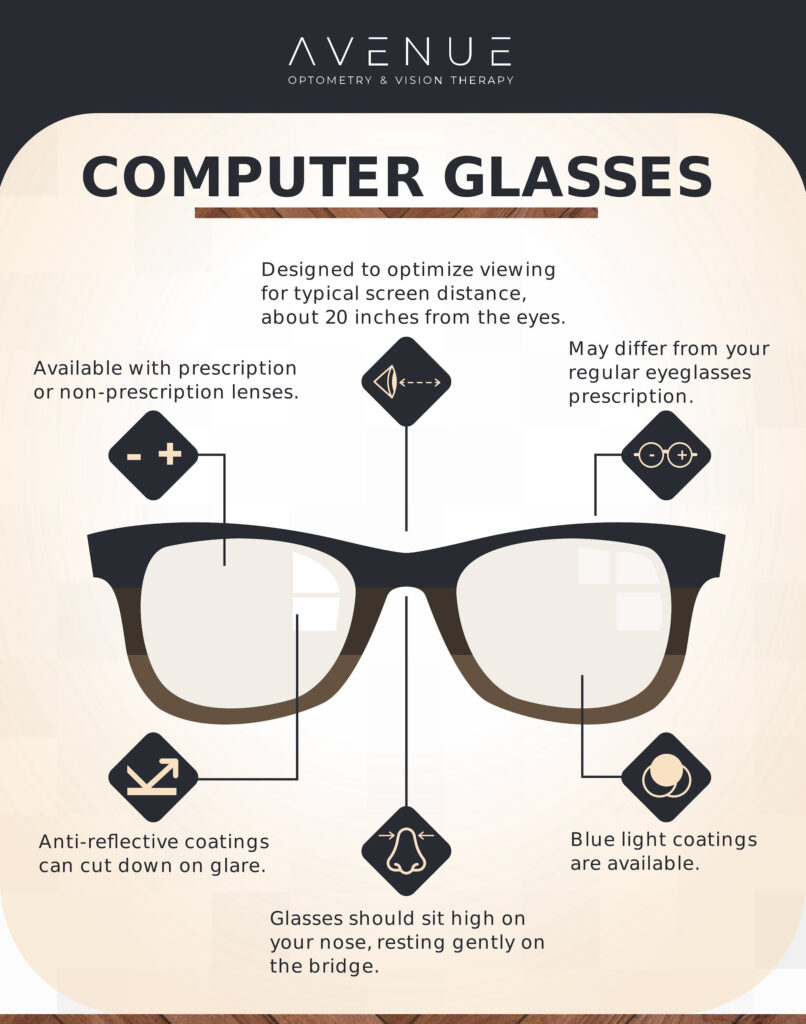In an era where screens are an indispensable part of our daily routines, the question of tailored eyewear for digital usage has never been more pertinent. Professionals and students worldwide seek relief from the digital eye strain more often than ever.
Your prescription for computer glasses depends on your individual eye care needs and how you use your devices. Typically, standard eyeglass prescriptions are optimized for reading printed material or distant viewing, not the intermediate distance computer screens are usually placed.
Computer glasses are designed to reduce eye strain by accommodating the unique visual requirements of screen use, so you might need a slightly different prescription. However, your regular prescription might suffice if you spend little time in front of a computer or digital device.
What Is Digital Eye Strain?
Digital eye strain, also known as computer vision syndrome, encompasses a group of eye and vision-related problems that occur after prolonged computer, tablet, e-reader, and cell phone use.
The eyes have to work harder to focus on a digital screen than on printed materials like books or newspapers because of how characters are represented (pixels), the tendency to blink less while using screens, and the increased focus on close-up work.
The most common symptoms associated with digital eye strain include:
- Headaches
- Blurred vision
- Dry eyes
- Neck and shoulder pain
These symptoms may be caused by poor lighting, glare on a digital screen, improper viewing distance, poor sitting posture, uncorrected vision problems, or a combination of these factors.
What Are Computer Glasses?
While traditional prescription lenses help correct vision problems like nearsightedness or farsightedness, computer glasses serve a more specialized role.
They are designed to optimize vision at the typical viewing distances for desktop and laptop screens, at least 20 inches from the eyes. The lenses offer a larger field of view to minimize eye movements and a different focusing power to reduce the strain on your eye muscles often associated with intensive computer use.

Getting a Prescription for Computer Glasses
If you don’t have an existing prescription for eyeglasses, your eye doctor will perform tests to determine your visual acuity and check for refractive errors.
If you have an existing prescription, your doctor will determine if it caters to your needs at a computer distance or if it needs adjustments. Even if you don’t wear eyeglasses, you can find significant relief from digital eye strain with properly prescribed computer glasses.
Prepare for Your Exam
During this exam, be prepared to discuss the specifics of your screen time, such as the average distance from your eyes to your computer or digital device, the duration of use, and any symptoms you’ve been experiencing. This information helps your optometrist assess your situation accurately and decide whether computer glasses could benefit you.
Signs You Need a Different Prescription
You might ignore blurry vision, headaches, or tired eyes, thinking it’s stress or fatigue. But if these happen often when you use a computer, it could mean your glasses aren’t right for digital work.
Choosing the Right Computer Glasses
Selecting the right pair of computer glasses goes beyond just getting a prescription. You’ll need to consider factors such as lens coatings that help reduce glare and lens tints that can enhance screen contrast.
The frames also play a crucial role in your comfort and style. A professional can make sure your glasses fit well, adjust them for comfort, and prevent them from slipping off your face, especially if you wear them for a long time.
Lens Types & Anti-Reflective Coatings
Anti-reflective coatings are especially beneficial for computer glasses, as they reduce the glare from computer screens and overhead lighting that can contribute to eye strain.
Blue light filter lenses are another popular choice for digital eyewear, as they can reduce exposure to the high-energy visible (HEV) blue light emitted by digital screens.
Tips for a Comfortable Fit
The ideal computer glasses should sit high on your nose, resting gently on the bridge. The lenses must be positioned so your eyes look through the centre of them to optimize your viewing and reduce strain.
How You Can Prevent Digital Eye Strain
Preventing or reducing digital eye strain involves:
- Taking steps to control lighting and glare on the digital screen.
- Ensuring proper seating posture.
- Taking regular breaks from screen time.
You can remember to take breaks by following the 20-20-20 rule: every 20 minutes, turn away from your screen and look at something 20 feet away for at least 20 seconds.
Regular Eye Exams
Digital eye strain can often be managed through a simple adjustment to your prescription. Your optometrist can conduct a specialized exam focused on the distance and how your eyes interact with a computer screen, checking that your prescription is attuned to this unique visual requirement.
If your eye strain symptoms persist long after you stop using your device, it’s time to consult with an eye doctor. They can offer personalized advice and solutions and rule out other issues contributing to your discomfort.
Get Fitted for Computer Glasses
It’s crucial to prioritize your eye health, particularly in an age where screens are omnipresent. Computer glasses with the correct prescription can help relieve digital eye strain and create a more comfortable and productive work experience.
If you’re considering computer glasses, visit Avenue Optometry & Vision Therapy for an eye exam. We can update your prescription, review lens coating options, and perform a professional fitting to set you up with comfortable eyewear.




